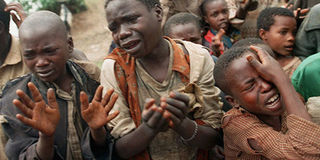The Rwanda Crisis from Uganda to DR Congo

The Path of Genocide: The Rwanda Crisis from Uganda
What you need to know:
- The different writers, though dealing with a similar topic but looking at it from different angles, don’t overlap each other in their presentation. They employ a comprehensible narrative without heavy academic jargon.
Though the book is about the genocide, the writers of the different chapters endeavour to give it significance beyond Rwanda and the region
The Path of Genocide: The Rwanda Crisis from Uganda to Zaire is more than just a book. The different brains and countries behind this book make it an ideal piece of literary work to be on ones bookshelf.
The authors are all internationally accomplished academicians who were brought together to study the causes of the genocide and why the international community failed to detect what was happening and call it by the right name.
This is a collection of brains from Uganda, Rwanda, DR Congo, Ethiopia, Norway, Britain, USA, France and Canada.
The authors analyse the background to the genocide and the roles played by neighbouring countries in fuelling the crisis. The book also tries to show how the international community failed to stop or mitigate the genocide.
The book came about as a result of the international community’s provision of development and relief assistance to aid those coming out of a war situation, only for more wars to erupt.
The book further digs into the history of the violence and what the international community knew in advance, as well as the action that was taken to prevent the crisis.
The 16 chapters of the book each focus on one dimension of the Rwanda conflict. Put together, they progressively tell the story of how the genocide unfolded and how the world responded.
From the subtitle The Rwanda Crisis from Uganda to Zaire, one may wonder how Uganda becomes the origin of the genocide.
In chapter one, titled Rwandan refugees and immigrants to Uganda, the author, Ogenga Otunnu, explains the genesis of the ethnicity link between the two major ethnic groups in Rwanda with their cousins in Uganda.
The chapter dealing with extremism in Rwanda, which was the central issue of the genocide, is written by two scholars from the antagonising ethnic groups – Joan Kakwenzire and Dixon Kamukama who are Tutsi and a Mwiru, the Ugandan equivalent of a Hutu. This was in an effort to ensure objectivity in spite of the pain suffered by the Tutsi authors.
Chapter 10 about Rwanda: US policy and television coverage focuses on the role of television by Livingston and Eachu. The two authors in detail show how the American media played in the shadow of what had happened in Somalia when US marines were killed and dragged in the streets of Mogadishu.
They also show how the media swayed the American policymakers by showing that Rwanda was of little or of no importance to America’s foreign policy during the time of the genocide.
The book would appeal to scholars of International Relations, peace and conflict resolution which formed the basis of the book.
The different writers, though dealing with a similar topic but looking at it from different angles, don’t overlap each other in their presentation. They employ a comprehensible narrative without heavy academic jargon.
Though the book is about the genocide, the writers of the different chapters endeavour to give it significance beyond Rwanda and the region.
Together they provide a narrative of a period which has witnessed not only a change in Central Africa, but also a radical re-examination of the involvement of states and international actors in humanitarian issues.
The more than 400-page book is published by New Jersey publishing house Transaction Publishers. Though not readily available on the local market, it is available on the Internet and with permission one can get a free soft copy.
Book review
Book title: The Path of Genocide: The Rwanda Crisis from Uganda to Zaire
Edited by: Howard Adelman and Astri Suhrke
Publisher: Transaction Publishers
Price: Shs126,000
Available at: Amazon.com
Reviewed by: Henry Lubega


